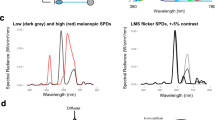Summary
We raised monocularly deprived kittens in visual environments with low level illumination that was either steady or flickering. With steady scotopic luminance ocular dominance shifted as it does in normal photopic lighting. In flickering light with an average frequency of 2 Hz there was virtually no ocular dominance shift, while in flickering light averaging 0.1 Hz there was a significant shift. Recordings from the 2 Hz flicker-reared were similar to the dark-reared recordings. The flickering illumination was produced in one case by a high contrast-low brightness TV near the cage, and in another case, by a low voltage incandescent bulb driven by a pseudo-random sequence generator. This circuit delivered either a maximum ON time of 1.7 s or a maximum of 40 s, for the 2 Hz and 0.1 Hz respectively. Both the TV and flickering bulb produced average illumination comparable to the dim (0.01 cd/ m2) steady scotopic illumination. We conclude that dim flickering light is not a sufficient stimulus for promoting ocular dominance shift in kittens in the critical period unless the flicker rate approaches 0.1 Hz. Furthermore results from the TV rearing suggest that flicker may be capable of preventing an ocular dominance shift expected from a concurrent steady low light level background.
Similar content being viewed by others
References
Aslin RN, Alberts JR, Petersen MR (ed) (1981) Development of perception, vol 2. The visual system. Academic Press, New York
Bear MF, Daniels JD (1983) The plastic response to monocular deprivation persists after chronic depletion of norepine-phrine. J Neurosci 3: 407–416
Blakemore C (1976) The conditions required for the maintenance of binocularity in the kitten's visual cortex. J Physiol (Lond) 261: 423–444
Blasdel GG, Pettigrew JD (1979) Degree of interocular synchrony required for maintenance of binocularity in kitten's visual cortex. J Neurophysiol 42: 1692–1710
Buisseret P, Imbert M (1976) Visual cortical cells: their developmental properties in normal and dark reared kittens. J Physiol (Lond) 255: 511–525
Cynader M, Berman N, Hein A (1973) Cats reared in stroboscopic illumination: effects on receptive fields in visual cortex. Proc Natl Acad Sci USA 70: 1353–1354
Daniels JD, Pettigrew JK, Norman JL (1978) Development of single neuron responses in kitten's lateral geniculate nucleus. J Neurophysiol 41: 1373–1392
Daw NW, Berman N, Ariel M (1978) Interaction of critical periods in the visual cortex of kittens. Science 199: 565–567
Hirsch HVB, Spinelli DN (1970) Visual experience modifies distribution of horizontally and vertically oriented receptive fields in cats. Science 168: 869–871
Kaufman L (1974) Sight and Mind. Oxford Press, London
Movshon JA, Van Sluyters RC (1981) Visual neural development. Ann Rev Psychol 32: 477–522
Ohzawa I, Selar G, Freeman RD (1982) Contrast gain control in the cat visual cortex. Nature 298: 266–268
Olson CR, Freeman RD (1980) Rescaling of the retinal map of visual space during growth of the kitten's eye. Brain Res 186: 55–65
Pettigrew JD, Freeman RD (1973) Visual experience without lines: effect on developing cortical neurons. Science 182: 599–601
Rauschecker JP, Singer W (1979) Changes in the circuitry of the kitten visual cortex are gated by postsynaptic activity. Nature 280: 58–60
Rauschecker JP, Singer W (1981) The effects of early visual experience on the cat's visual cortex and their possible explanation by Hebb synapses. J Physiol (Lond) 310: 215–240
Sclar G, Ohzawa I, Freeman RD (1983) Contrast adaptation in kitten visual cortex. Invest Ophthalmol Vis Sci (Suppl) 24: 139
Sherman SM, Spear PD (1982) Organization of visual pathways in normal and visually deprived cats. Physiol Rev 62: 738–855
Spear PD, Tong L, Langsetmo A (1978) Striate cortex neurons of binocularly deprived kittens respond to visual stimuli through closed eyelids. Brain Res 155: 141–146
Van Sluyters RC, Blakemore C (1973) Experimental creation of unusual neuronal properties in visual cortex of kittens. Nature 246: 506–508
Wiesel TN, Hubel DH (1963) Single-cell responses in striate cortex of kittens deprived of vision in one eye. J Neurophysiol 26: 1003–1017
Author information
Authors and Affiliations
Additional information
This work was supported by ONR Contract N00014-81-K-0136. Flaxedil was supplied by Lederle Laboratories. We thank K. Cullen, M. Sutter, J. Kape and M. Motuz for technical assistance. L.N. Cooper and J.P. Rauschecker provided helpful comments.
Rights and permissions
About this article
Cite this article
Daniels, J.D., Pressman, E., Schwartz, M. et al. Effects of luminance and flicker on ocular dominance shift in kitten visual cortex. Exp Brain Res 54, 186–190 (1984). https://doi.org/10.1007/BF00235830
Received:
Accepted:
Issue Date:
DOI: https://doi.org/10.1007/BF00235830




